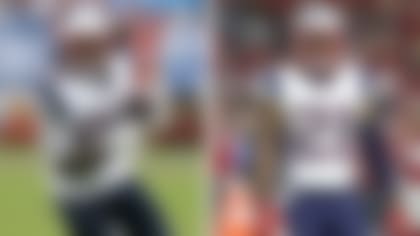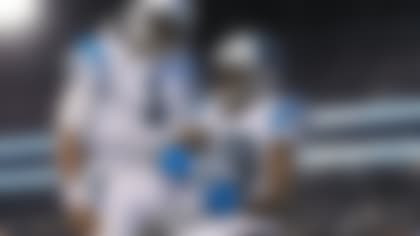I was hardly surprised when Rex Ryan boldly predicted the Buffalo Bills would field the NFL's No. 1 defense, but I did wonder how the defensive wizard would reshape the unit to help make it the premier defense in football. The boisterous defensive-play designer is in charge of the most talented unit he's ever coached, with playmakers at every level capable of executing the exotic schemes he prefers. With Ryan sprinkling in some swagger and fearlessness, the Bills' defense could truly be special in 2015. First, of course, they have to get past Tom Brady and the Patriotsin Week 2.
Given some time to look at the All-22 Coaches Film of the Bills' impressive Week 1 win over the Colts, I've come up with three reasons to think the defense will make serious noise under Ryan's direction -- along with specific tactics I expect Buffalo to turn to against its AFC East rivals this Sunday:
1) The new scheme features more creative pressures and exotic coverage.
There's no disputing Ryan's reputation as one of the finest defensive minds in football. He is a brilliant tactician with a knack for creating disruption at the point of attack with a variety of unorthodox blitzes and simulated pressures from 3-4, 4-3, "46", 6-1 and "Okie" sub-package fronts. Unlike those coaches who are wedded to a particular front or scheme, Ryan is versatile and willing to incorporate different looks to exploit a potential mismatch along the line, or create an overload possibility from the strong or weak side. With coordinator Dennis Thurman adept at building coverages to complement the dynamic fronts, the Bills can befuddle veteran quarterbacks with their unconventional pressure packages.
In Week 1, the Bills tossed a variety of eccentric looks and exotic pressures at Andrew Luck to disrupt his timing and rhythm from the pocket. From simple blitzes from a base 4-3 alignment to double-A-gap pressures and overload blitzes from sub-package fronts, the Bills attacked the three-time Pro Bowler from every angle throughout the game. The Bills' "psycho" look, which features seven defenders within 5 yards of the ball in a "stand up" position, leads to frenetic pressure. With Luck and center Khaled Holmes (a third-year pro) unable to consistently identify the Mike linebacker while setting the pass protection, Ryan's clever scheming resulted in a few clean shots on the quarterback. Given the impact of sacks and hits on a quarterback's internal clock, it is no coincidence Luck was off his game.
In the play depicted below, taken from that win over the Colts, the Bills are in a double-A-gap blitz alignment, with safety Aaron Williams creeping to the line of scrimmage. At the snap, Williams follows linebacker Nigel Bradham through the A gap to maximize the inside rush. With the Colts overwhelmed on the interior, Luck is forced eat the ball and take a costly sack on second down. (TO VIEW THE PLAY, SCROLL LEFT TO RIGHT ON THE IMAGE BELOW):
In the play depicted below, from the first quarter Sunday, the Bills are aligned in a "46" front, with double edge pressure called. Linemen Jerry Hughes and Kyle Williams are positioned side by side to attack the C and B gaps, respectively. Because there are seven defenders near the line of scrimmage, no Colts player will be available to help stop either Hughes or Williams, virtually assuring that one of them will get to the quarterback against one-on-one protection. Williams works past his blocker to put a big hit on Luck as he passes the ball. Though this results in an incomplete pass rather than a sack, the hit lets Luck know the Bills will be bringing the heat at all times. (TO VIEW THE PLAY, SCROLL LEFT TO RIGHT ON THE IMAGE BELOW):
Against the Patriots this Sunday, the Bills will continue to use a number of exotic looks to disrupt Tom Brady's timing in the pocket. Although New England will likely counter by playing "dink and dunk" football from spread formations, the heavy assault could force Brady to take a lot of hits and eventually disrupt his game.
2) Ryan will unleash the NFL's most talented D-line to wreak havoc on QBs.
When Ryan landed the job in Buffalo, offensive coordinators around the NFL surely cringed at the thought of the defensive mastermind directing a line stacked with Pro Bowler-caliber playmakers at every position. The quartet spearheaded a pass rush that led the NFL in sacks (54) last season with minimal blitzing from ex-defensive coordinator Jim Schwartz. Under Ryan's protégé Mike Pettine in 2013, the defensive line accounted for 71.9 percent (41) of the team's sacks (57), thriving in a blitz-heavy approach that created plenty of one-on-one opportunities at the line.
With Ryan employing a similar scheme with extra rushers attacking the pocket from various angles, opponents are forced to leave a dynamic rusher singled up on the edges or along the interior. This gives the Bills a decided advantage when bringing pressure or bluffing, because it creates confusion, hesitancy and disruptive opportunities.
In the play depicted below, from the fourth quarter on Sunday, the Bills use an exotic pressure to create a sack opportunity for Kyle Williams. The defense is standing around in a "psycho" look prior to the snap before executing an overload blitz on the defensive right. With the offense unable to identify the potential rushers prior to the snap, the overload pressure springs Williams free when the running back fails to pick up the correct rusher. Although the Pro Bowler didn't register the sack on the play, he forced Luck to flee the pocket, with Nickell Robey eventually bringing Luck down from the back side. (TO VIEW THE PLAY, SCROLL LEFT TO RIGHT ON THE IMAGE BELOW):
The combination of blitzes and simulated pressures only netted two sacks Sunday, but the tactics completely disrupted the timing of the passing game. Luck was clearly affected by the threat of the blitz, leading to hurried and errant throws from the pocket. Additionally, the cumulative effect of the early hits within the pocket led the young quarterback to "see ghosts" (a quarterback who is seeing ghosts will sense pressure coming from multiple angles even when the defense is only bringing a standard four-man pass rush) whenever the Bills bluffed pressure at the line. Buffalo was able to create the illusion of pressure without removing a defender from coverage. As a result, Luck repeatedly fired "hot" throws into heavy traffic instead of delivering balls into the voids created by blitzes.
The Bills would be wise to incorporate similar tactics against the Patriots, to take advantage of the youth and inexperience of New England's interior blockers. The Patriots are leaning on three rookies on the line (guards Shaq Mason and Tre Jackson and center David Andrews), which is a scary thought heading into their matchup with the Bills' vaunted front. Marcell Dareus -- returning from a one-game suspension -- and Kyle Williams could destroy the timing of the passing game with their first-step quickness and sudden penetration up the gut. Given Brady's lack of mobility, it makes sense to pressure him down the middle, putting the pressure directly in the veteran's face.
On the edges, Mario Williams and Jerry Hughes could create a headache for the Patriots with their speed, quickness and burst. While Hughes is most likely to use his speed to turn the corner, it is the deadly combination of strength and power that makes Williams the one to watch in this matchup. He is not only capable of running around or through Nate Solder, but he could move around to various locations to take advantage of a "fish" along the line. If Ryan spots one of the Patriots' offensive linemen struggling early, expect the wizard to direct his top pass rusher through an accompanying gap to exploit the weakness.
3) The ultra-athletic secondary can suffocate any offensive attack.
The Bills' secondary is rarely mentioned in the same breath as some of the elite units in football, but I feel it's time to heap some praise on Ryan's troops after watching the group grow throughout the preseason. Stephon Gilmore and Aaron Williams are on the verge of becoming Pro Bowl-caliber playmakers on the perimeter. Each player displays the athleticism, instincts and awareness to deliver impact plays in bunches, and Ryan's scheme provides plenty of opportunities to make plays on the ball.
The Bills have stockpiled the secondary with a group of athletic role players who have the core traits needed to succeed as sub-package players in the secondary. Nickell Robey and Ron Darby, in particular, are natural nickel corners with the short-area quickness and movement skills to shadow shifty receivers in space. In addition, Robey is a dynamic rusher off the edges with a keen sense of timing on second-level blitzes. Given their collective abilities as hybrid secondary defenders, the Bills are able to employ a variety of man, zone and blitz schemes with multiple defenders exchanging roles to create chaos all over the field.
Gilmore and Williams were central figures in a game plan that limited Luck and Co. to only 304 total yards Sunday, including only 243 passing yards. Most importantly, the Bills forced three turnovers (two interceptions and a fumble) that showcased their collective speed, quickness and ball-hawking skills in the back end. The Bills were able to lock down the Colts' receivers in one-on-one coverage behind blitzes and simulated pressures up front. Interestingly, Buffalo boldly matched Darby up with WR1 T.Y. Hilton and instructed Gilmore to follow Andre Johnson around the field. Placing a rookie corner on an established veteran is certainly risky, but the Bills routinely floated a corner in his direction to protect him over the top.
Gilmore showed lock-down cover skills against an aging Johnson. He challenged him at the line on occasion, but also showed the ability to drive hard on short and intermediate throws from "off" coverage. This allows Ryan to aggressively employ a wide range of cover schemes, including Cover-0 (all-out blitz), Cover-3 (three-deep zone) and Cover-6 (zone-dogs), to give the quarterback a different look.
In the play depicted below, taken from the second quarter Sunday, Gilmore provides the perfect example of his exemplary cover skills. The Bills are aligned in an "under" front, with Williams positioned close to the box. Williams will execute a safety blitz through the B gap from his alignment. Gilmore uses a bail technique to stay over the top of Hilton on his go-route. Luck is forced to release the ball early due to the pressure, and Gilmore is in the perfect position to break up the pass. (TO VIEW THE PLAY, SCROLL LEFT TO RIGHT ON THE IMAGE BELOW):
Gilmore's solid play on the island gives Ryan a lot of options when it comes to defending the Patriots' passing game. He could cover the Patriots' WR1 (Julian Edelman) all over the field or allow Darby to follow the shifty pass catcher and concentrate on locking down the back side. Although Gilmore has campaigned to cover Rob Gronkowski, the size disparity simply doesn't make the matchup a good one for the Bills.
Aaron Williams, however, could be an intriguing option in coverage on Gronkowski. He brings corner skills to the position and is athletic enough to shadow the touchdown machine with a little assistance from the Bills' hard-hitting linebackers at the line of scrimmage. If Ryan elects to put his one of his emerging superstars in the role, buzz could quickly grow about the team's talented tandem in the secondary.
Follow Bucky Brooks on Twitter @BuckyBrooks.












